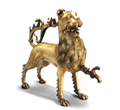A Global Appetite: Food History as World History from 1500 to 1800
Megan Elias
About the Tour
The Global Appetite tour of the European Decorative Arts and the European Painting collections of the Metropolitan Museum emphasizes the historical importance of food in world history as both a catalyst and consequence of larger trends and events. The audio tour focuses on the ages of exploration and empire, when Europeans diversified their larders just as they enriched their treasuries, and invites students to trace the history of European expansion in the paintings, tankards, finger bowls, and chocolate pots they examine.
Annotated Bibliography of Printed Resources
Albala, Ken. Eating Right in the Renaissance. Berkeley : University of California Press, 2002
Glanville, Philippa and Hilary Young. Elegant Eating: Four Hundred Years of Dining in Style. New York, NY : Harry N. Abrams, 2004.
Maguelonne Toussaint-Samat, A History of Food. Chichester, West Sussex, U.K. ; Malden, MA : Wiley-Blackwell, 2009.
Mintz, Sidney, Sweetness and Power. New York : Penguin Books, 1986.
Annotated Bibliography of Web Resources
http://www.foodtimeline.org
This site provides basic information and useful references to more in depth material on a wide variety of food substances. It is a good place to start any research into food, past or present. To help in understanding some of the material on this tour, look up sugar, spice, and chocolate.
http://www.gilderlehrman.org/historynow/06_2007/historian2.php
This brief essay by Alfred Crosby explains the concept of the Columbian Exchange, which provides a good background for understanding how world cultures were changed—not just in terms of food—by Columbus’s arrival in the Americas.
http://collections.vam.ac.uk/
The Victoria and Albert Museum in England has a world-renowned collection of dining implements. Using the “Search the collections” feature, you can find many examples of nefs, sugar casters, and chocolate pots like those seen on the tour and learn more about their relevance in cultural history.
Additional Materials, Activities and Exercises
Possible Student Assignments
Using the notes you collected while on the tour, write a paper in which you explain the connections between each of the items you encountered.
Read the Alfred Crosby’s The Columbian Exchange. Write a paper explaining how the items you encountered on the tour illustrate Crosby’s thesis.
Choose one item that you encountered on the tour and create a list of sources that would tell you more about the item and the history both of its creation and its use. Write a paper in which you explain the following: 1. What made you choose this item? 2.What were you able to learn about the item from the sources you identified?
Visit any museum and catalog five items on display that are connected with food in some way. Provide full titles and dates for each item and explain its connection to food. In what ways are these items connected to each other through their connection to food?
What is your favorite meal? Write down each element of the meal so that you are sure you have included all foodstuffs involved in creating that meal. For example, if you like chocolate cake you will need to know what the ingredients of chocolate cake are. Once you have assembled your list of ingredients create a bibliography, or list of books that will explain the history and/or contemporary issues surrounding each ingredient.
Visit a food market. Write down the geographic origins of ten items in the market. Note the item and its origin as well as its price. Create a map which indicates the origins of each of your ten items. Include prices on your map. What patterns do you see?
Read Chapter about the history of coffee and chocolate in A History of Food and read Sweetness and Power. How do these two texts support or undermine each other’s arguments? How are the histories of sugar and caffeinated drinks connected?
Sites:
The Metropolitan Museum of Art, New York City
Tags:
Global Encounters|Metropolitan Museum

